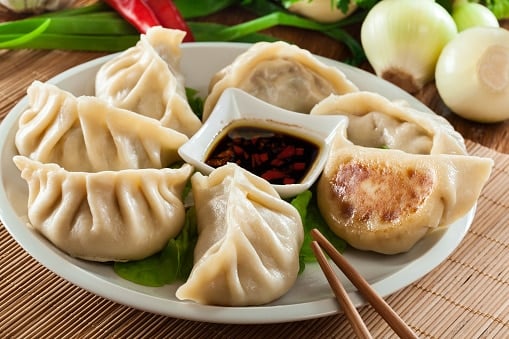Moms, get ready for a delicious showdown of potstickers vs. dumplings! Crispy potstickers and soft, savory dumplings will battle for the ultimate family treat title. Whether your little ones love the crunch of potstickers or the comforting dumplings, we’ll explore why both promise a satisfying mealtime experience. So read on and see which one of these delicious treats will be the winner for your family: potstickers or dumplings!
Potstickers vs. Dumplings – 5 Key Differences
Some use the terms “potstickers” and “dumplings” interchangeably which can be confusing. Below are five distinct differences between potstickers vs. dumplings:
1. Culinary Origin
Potstickers usually refer to Chinese cuisine, where they are considered a popular snack or appetizer. They are often served during festivals and family gatherings.
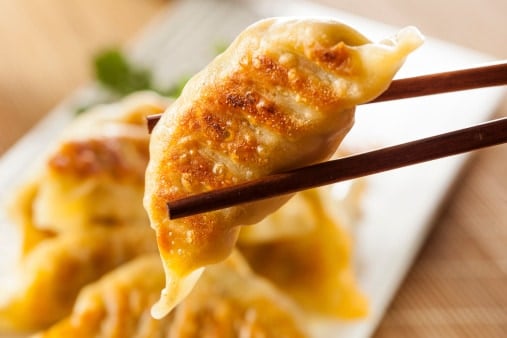
©bhofack2/iStock via Getty Images
Dumplings can be found in various cuisines worldwide, including China, Japan, Korea, and Europe. They are enjoyed as appetizers, main dishes, or desserts. They symbolize prosperity, good fortune, and communal dining in various cultures worldwide.
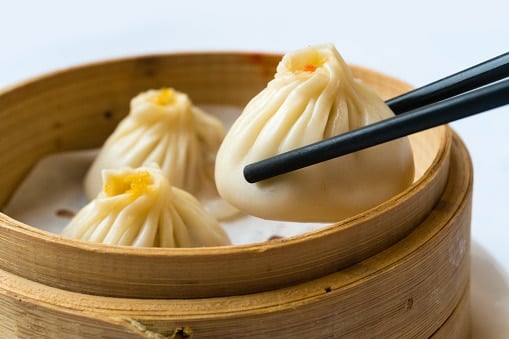
©ymgerman/iStock via Getty Images
2. Appearance
Potstickers are small, round, or crescent-shaped parcels made with thin dough wrappers. Due to their pan-frying method, potstickers stand out by having a crispy and browned bottom, while the top remains softer and more delicate. For that reason, with every bite, you feel the crispy outer layer and taste the burst of flavors and tenderness inside.
Dumplings come in various shapes and sizes. Their look depends on their regional and cultural origins. All in all, they can have smooth or pleated edges, with the same texture throughout. Dumplings have a savory chewiness to each bite.
3. Wrapper Thickness
Potstickers have wrappers that vary in depth. The thin ones provide a delicate contrast to the crispy bottom and tender filling. However, potstickers usually have a thick, doughy wrapper that can hold up to the heat without falling apart. So the overall texture provides a satisfying chewiness that pairs well with the crispy exterior.
Dumplings normally have thin and delicate wrappers that practically melt in your mouth, allowing the flavors of the filling to shine through. Others have slightly thicker wrappers, adding a satisfying chewiness to each bite.
4. Fillings
Potstickers often include a mixture of meat (commonly pork) and vegetables, seasoned with various spices and sauces.
Dumplings on the other hand, can have a wide range of fillings, including meat, vegetables, seafood, and even sweet fillings like fruits or chocolate, depending on the cultural influence.
5. Cooking Method
Potstickers have a unique two-step process for cooking. First they are pan-fried to create a crispy bottom and then steamed to cook the filling and seal the top.
Dumplings are typically boiled, steamed, or fried, without the specific pan-frying method like that of potstickers.
Now let's dig into how to prepare a savory potsticker meal!
How to Prepare Tasty Potstickers
Here’s a 5-step process to make your potstickers at home…
Step 1 – Gather your ingredients:
Potsticker wrappers: You can find pre-made wrappers in the refrigerated section of most grocery stores or make them from scratch using a simple dough recipe.
Filling: Choose a filling that includes ground meat (such as pork, chicken, or beef), finely chopped vegetables (cabbage, carrots, mushrooms), seasonings (soy sauce, ginger, garlic), and optional additions like green onions or sesame oil.
Step 2 – Prepare the Filling:
In a mixing bowl, combine the ground meat, vegetables, seasonings, and any additional ingredients. Mix well until everything is evenly distributed. Now for the best flavor, let the filling rest in the refrigerator for about 30 minutes to allow the flavors to meld together.
Step 3 – Assemble the Potstickers:
Take a potsticker wrapper and place a spoonful of the filling in the center. Then moisten the edges of the wrapper with water using your finger or a brush. Next fold the wrapper in half, creating a half-moon shape. Finally, pinch the edges together firmly to seal the potsticker.
You can leave them as is or create pleats along the edge for a decorative touch.
Step 4 – Cook the Potstickers:
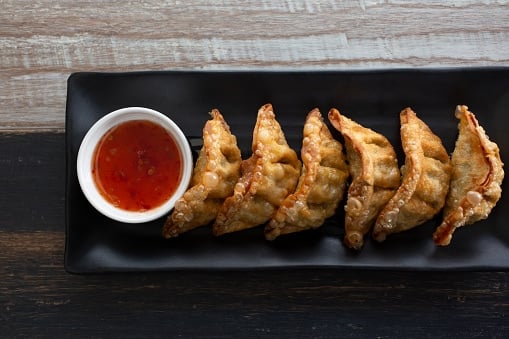
©Photography By Tonelson/iStock via Getty Images
Heat a non-stick pan over medium heat and add a small amount of oil.
Place the potstickers in a single layer, flat side down, in the pan. Make sure they are not touching each other.
Let the potstickers cook for a few minutes until the bottoms become golden brown and crispy.
Step 5 – Add Water and Steam:
Carefully pour a small amount of water (about a quarter cup) into the pan, enough to cover the bottom of the pan. Then quickly cover the pan with a lid to trap the steam inside. This will cook the filling and create a tender texture.
Allow the potstickers to steam for about 6-8 minutes or until the water has evaporated.
Remove the lid, and you'll be greeted with the enticing aroma of perfectly cooked potstickers. Finally, carefully transfer them to a serving platter, ensuring the crispy bottoms remain intact.
Potstickers are traditionally served hot with a dipping sauce made from soy sauce, rice vinegar, and a touch of sesame oil. You can also experiment with other sauces like chili oil or sweet and sour sauce to enhance the flavor profile.
So, with a few simple steps and a combination of pan-frying and steaming, you can create homemade potstickers that boast a delightful contrast between their crispy bottoms and succulent fillings. Enjoy the process of crafting these crispy delights, and savor the satisfaction of each mouthwatering bite.
7 Healthy Benefits of Potstickers
- Boosts Energy: Potstickers typically contain a combination of ground meat, vegetables, and seasonings, providing a balanced mix of macronutrients. Macronutrients are what give us energy and come from fat, protein, and carbs. So for instance, the filling can include lean protein from sources like chicken or pork, which helps support muscle growth and repair.
- Rich in Vegetables: Great way for kids to eat their veggies! For instance, potstickers can include a variety of vegetables such as cabbage, mushrooms, and scallions. For the most part, they are full of vitamins, minerals, and dietary fiber. They also add vibrant colors and flavors to the filling.
- Source of Dietary Fiber: Potstickers include ingredients to help with digestion and maintain regular bowel movements. Also, the fillings can help to give you a longer feeling of fullness, which may support weight management.
- Rich in vitamins and minerals: Depending on the ingredients you choose for your family, potstickers can be a source of various vitamins and minerals. For example, cabbage is rich in vitamin C, vitamin K, and folate, while mushrooms provide B vitamins and minerals like selenium and potassium.
- Helps Control Sodium Intake: By preparing potstickers at home, you have control over the amount of sodium added to the filling and the dipping sauce. Using reduced-sodium soy sauce or alternative seasonings can help lower the overall sodium content.
- Reduces Fat intake: The combination of pan-frying and steaming in potstickers can help minimize the need for excessive oil. Pan-frying gives them a crisp bottom while using minimal oil, and steaming helps cook the filling without adding extra fat.
- Portion Control: Potstickers can be enjoyed in moderation, making portion control easier. By being mindful of the number of potstickers consumed, you can fit them into a balanced family meal plan without overindulging.
Now let's prepare a savory dumpling dish!
How to Prepare Tasty Dumplings
Here's a 5-step process to make delicious dumplings at home…
Step 1 – Gather the Ingredients:
Dumpling wrappers: You can buy pre-made wrappers or make them yourself using flour and water. After that, you add your filling.
For example, you can choose your favorite ingredients like ground meat (pork, chicken, beef), finely chopped vegetables (cabbage, carrots, mushrooms), and seasonings (soy sauce, ginger, garlic).
Step 2 – Prepare the Filling:
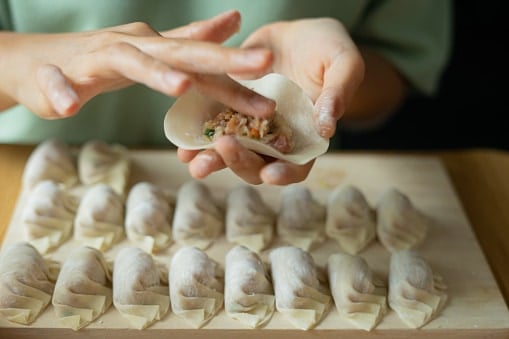
©Jaturapat Fungkajorn/iStock via Getty Images
In a bowl, mix the ground meat, vegetables, and seasonings together until well combined. Then let the filling rest in the refrigerator for about 20-30 minutes to enhance the flavors.
Step 3 – Assemble the Dumplings:
Take a dumpling wrapper and place a spoonful of the filling in the center. Next, moisten the edges of the wrapper with water to help seal it. And finally, fold the wrapper in half and press the edges firmly to seal them.
Step 4 – Choose a Cooking Method:
Steaming: Place the dumplings in a steamer basket and steam them for 10-12 minutes until the wrappers turn translucent.
Boiling: Drop the dumplings into boiling water and cook them for 6-8 minutes until they float to the surface.
Step 5 – Serve and Enjoy:
Transfer the cooked dumplings to a serving plate. Then serve them with dipping sauces like soy sauce, vinegar, or a combination of both.
Enjoy the dumplings while they are hot, savoring the tasty flavors and textures.
All in all, preparing dumplings is a fun and delicious activity your whole can enjoy together! Feel free to experiment with different dipping sauces, fillings and cooking methods to create your own unique dumpling creations. Get creative and enjoy the process of making and sharing these delightful treats with your loved ones.
7 Healthy Benefits of Dumplings
- Promotes healthy digestion: Dumplings may include fibrous vegetables like cabbage, carrots, or mushrooms, which promote digestive health and help regulate bowel movements.
- Nutrient-rich fillings: Dumplings often contain a variety of fillings, such as vegetables, lean meats, seafood, and herbs, providing a wide range of essential nutrients like vitamins, minerals, and proteins.
- Controlled portion sizes: Dumplings are typically small in size, making it easier to manage portion control and prevent overeating.
- Lower caloric intake: Steamed dumplings are a healthier alternative to fried ones, reducing the intake of unhealthy fats and calories.
- Promotes heart health: Dumplings with lean meat or vegetable fillings are low in cholesterol, promoting heart health and reducing the risk of cardiovascular diseases.
- Antioxidants: Some ingredients used in dumplings, such as garlic, ginger, and green onions, contain antioxidants that can boost the immune system and protect the body from oxidative stress.
- Balanced meal option: Asian dumplings often combine various food groups to provide a balanced meal option. For instance, they can include proteins, vegetables, and carbohydrates in one convenient package, offering a balanced meal option.
Conclusion
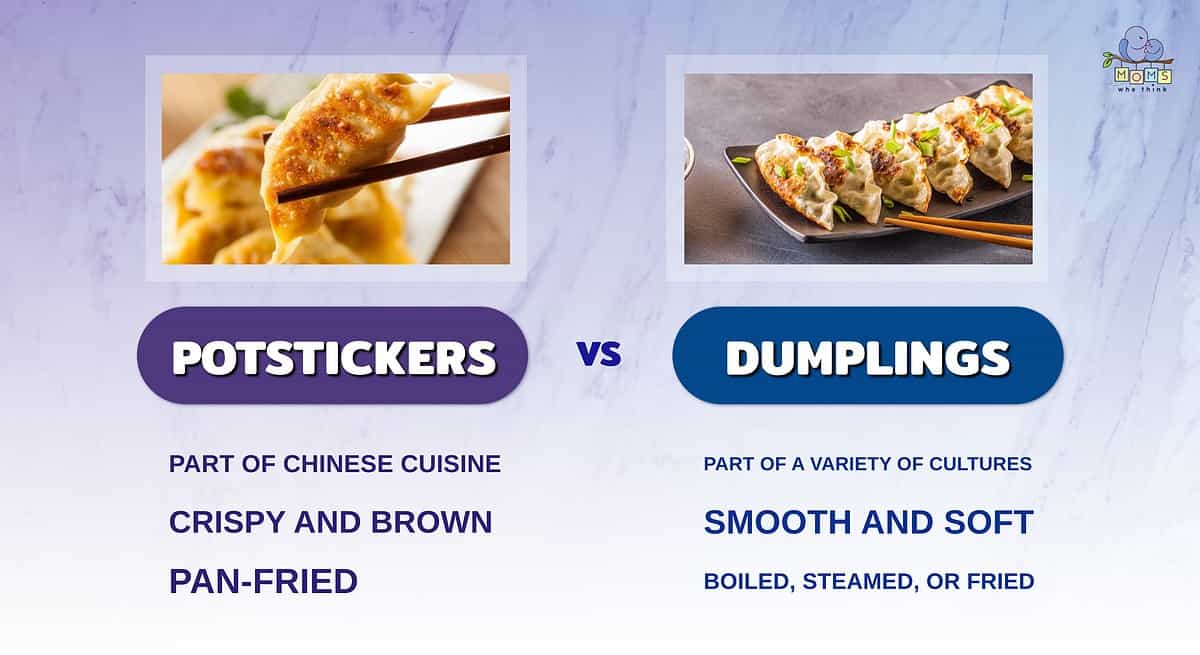
- Potstickers are distinctly a part of Chinese cuisine. While dumplings are also part of Chinese cuisine, they are enjoyed in a number of other Asian and European cuisines as well.
- Potstickers are crisp and brown, due to the way they are cooked. If you're craving a satisfying crunch, potstickers are the way to go. If something soft is more to your liking, dumplings are right up your alley.
- Dumplings can be boiled, steamed, or fried (although they aren't pan-fried), while potstickers are always pan-fried.
To summarize, potstickers and dumplings offer a delightful culinary adventure for you and your family. Whether you prefer the crispy potstickers or the flavorful dumplings, both dishes have something special to enjoy. So embrace the cultural significance and sample the differences between potstickers vs. dumplings, and let the textures and flavors transport you to distant lands with every delectable bite.
All in all, by making mindful choices, you can ensure a tasty and healthy meal. This is the perfect opportunity to add meaning to your family time. It’s like you and your family traveling the world through flavors and exploring different cuisines right at home!
The image featured at the top of this post is ©fotek/iStock via Getty Images.
